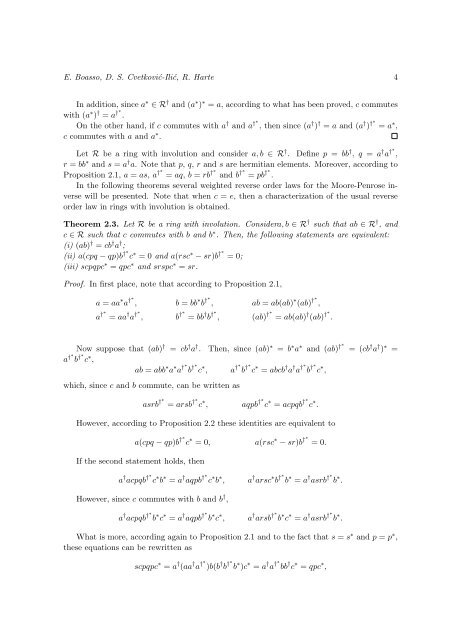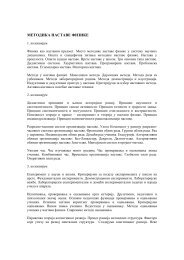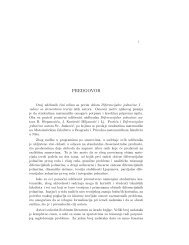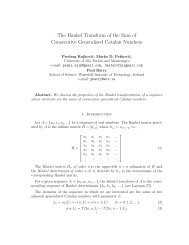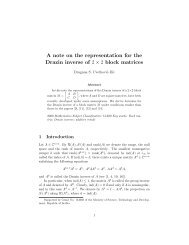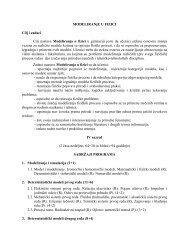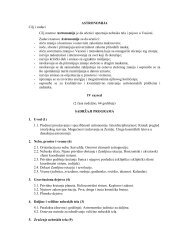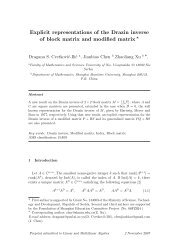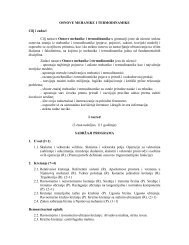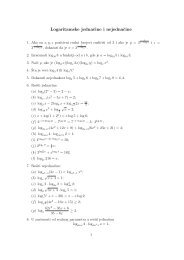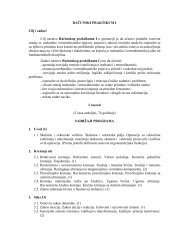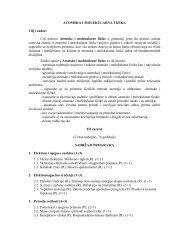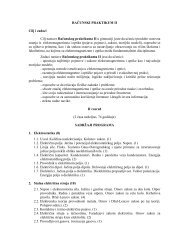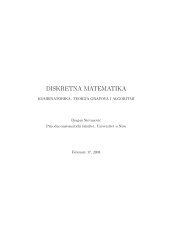On weighted reverse order laws for the Moore-Penrose inverse and ...
On weighted reverse order laws for the Moore-Penrose inverse and ...
On weighted reverse order laws for the Moore-Penrose inverse and ...
Create successful ePaper yourself
Turn your PDF publications into a flip-book with our unique Google optimized e-Paper software.
E. Boasso, D. S. Cvetković-Ilić, R. Harte 4<br />
In addition, since a ∗ ∈ R † <strong>and</strong> (a ∗ ) ∗ = a, according to what has been proved, c commutes<br />
with (a ∗ ) † = a †∗ .<br />
<strong>On</strong> <strong>the</strong> o<strong>the</strong>r h<strong>and</strong>, if c commutes with a † <strong>and</strong> a †∗ , <strong>the</strong>n since (a † ) † = a <strong>and</strong> (a † ) †∗ = a ∗ ,<br />
c commutes with a <strong>and</strong> a ∗ .<br />
Let R be a ring with involution <strong>and</strong> consider a, b ∈ R † . Define p = bb † , q = a † a †∗ ,<br />
r = bb ∗ <strong>and</strong> s = a † a. Note that p, q, r <strong>and</strong> s are hermitian elements. Moreover, according to<br />
Proposition 2.1, a = as, a †∗ = aq, b = rb †∗ <strong>and</strong> b †∗ = pb †∗ .<br />
In <strong>the</strong> following <strong>the</strong>orems several <strong>weighted</strong> <strong>reverse</strong> <strong>order</strong> <strong>laws</strong> <strong>for</strong> <strong>the</strong> <strong>Moore</strong>-<strong>Penrose</strong> <strong>inverse</strong><br />
will be presented. Note that when c = e, <strong>the</strong>n a characterization of <strong>the</strong> usual <strong>reverse</strong><br />
<strong>order</strong> law in rings with involution is obtained.<br />
Theorem 2.3. Let R be a ring with involution. Considera, b ∈ R † such that ab ∈ R † , <strong>and</strong><br />
c ∈ R such that c commutes with b <strong>and</strong> b ∗ . Then, <strong>the</strong> following statements are equivalent:<br />
(i) (ab) † = cb † a † ;<br />
(ii) a(cpq − qp)b †∗ c ∗ = 0 <strong>and</strong> a(rsc ∗ − sr)b †∗ = 0;<br />
(iii) scpqpc ∗ = qpc ∗ <strong>and</strong> srspc ∗ = sr.<br />
Proof. In first place, note that according to Proposition 2.1,<br />
a = aa ∗ a †∗ , b = bb ∗ b †∗ , ab = ab(ab) ∗ (ab) †∗ ,<br />
a †∗ = aa † a †∗ , b †∗ = bb † b †∗ , (ab) †∗ = ab(ab) † (ab) †∗ .<br />
Now suppose that (ab) † = cb † a † . Then, since (ab) ∗ = b ∗ a ∗ <strong>and</strong> (ab) †∗ = (cb † a † ) ∗ =<br />
a †∗ b †∗ c ∗ ,<br />
ab = abb ∗ a ∗ a †∗ b †∗ c ∗ , a †∗ b †∗ c ∗ = abcb † a † a †∗ b †∗ c ∗ ,<br />
which, since c <strong>and</strong> b commute, can be written as<br />
asrb †∗ = arsb †∗ c ∗ , aqpb †∗ c ∗ = acpqb †∗ c ∗ .<br />
However, according to Proposition 2.2 <strong>the</strong>se identities are equivalent to<br />
a(cpq − qp)b †∗ c ∗ = 0, a(rsc ∗ − sr)b †∗ = 0.<br />
If <strong>the</strong> second statement holds, <strong>the</strong>n<br />
a † acpqb †∗ c ∗ b ∗ = a † aqpb †∗ c ∗ b ∗ , a † arsc ∗ b †∗ b ∗ = a † asrb †∗ b ∗ .<br />
However, since c commutes with b <strong>and</strong> b † ,<br />
a † acpqb †∗ b ∗ c ∗ = a † aqpb †∗ b ∗ c ∗ , a † arsb †∗ b ∗ c ∗ = a † asrb †∗ b ∗ .<br />
What is more, according again to Proposition 2.1 <strong>and</strong> to <strong>the</strong> fact that s = s ∗ <strong>and</strong> p = p ∗ ,<br />
<strong>the</strong>se equations can be rewritten as<br />
scpqpc ∗ = a † (aa † a †∗ )b(b † b †∗ b ∗ )c ∗ = a † a †∗ bb † c ∗ = qpc ∗ ,


